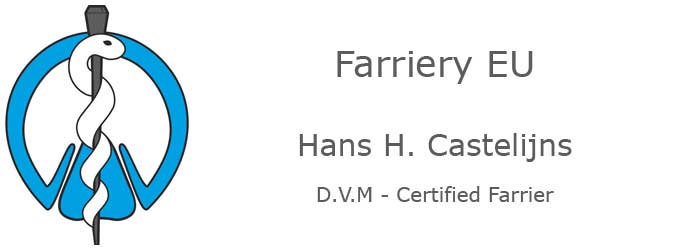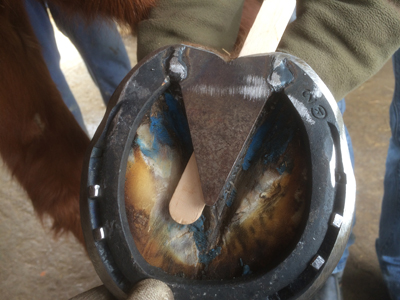 |
Shoeing with the heart and the head, appropriate uses of the heart-bar shoe, including hoof wounds. |
||
|
||
Heart-bar shoes have a long tradition but are not the easiest shoes to fit properly. The frog plate needs to be adjusted in length; not further forward than about 1 cm behind the tip of the trimmed frog, in orientation; with its center line over the central sulcus of the frog, and in depth; so as to get the desired type of contact , or lack of it, with the frog. They can be used in three manners as related to the contact the heart-bar insert takes with the frog: Positive pressure on the frog. When the shoe is ready to be nailed on to the trimmed foot, the frog plate takes contact with the frog before the heels of the shoe come in contact with the heels of the trimmed foot. On nailing the shoe on, the frog is already actively engaged in to weight bearing. This is the preferred method for treating hoof-wall defects like quarter cracks, laminitis or certain hoof wounds, as it allows for the affected parts of the hoof wall to be unloaded by recruiting the frog in to active weight-bearing. |
||
|
||
Positive pressure HB for a large hoof wound. Before applying a heart bar shoe in this way, it is of course necessary to have a healthy frog and to check that the horse will tolerate the pressure on this area of the foot by doing a pressure test. The author makes the horse stand on a wooden handle ( of a hoof knife e.g.) while picking up the contralateral limb. If the horse shows reluctance, it is wise to modify the shoeing plan. If positive frog pressure is desired, the shoe should preferably be fitted hot before the frog plate is applied to the shoe at the desired depth. If the frog plate is already fitted to the shoe, the back part of the shoe can be cooled in water before hot fitting the shoe, otherwise the early frog contact will be partially burnt away resulting in a heart-bar with neutral pressure. Neutral pressure on the frog. In this case, the heels of the shoe and the frog plate make contact simultaneously with the heels and the frog of the foot when presenting the ready heart bar shoe on to the trimmed foot. This type of application can be used when the aim is to widen the ground surface at the back of the shoe without overloading weak or underrun heels in horses which can be painful with too much frog pressure. Finally there is the use of the heart bar shoe with negative pressure. Here the frog plate’s use is aimed at preventing ground contact with the frog, for example in horses with painful navicular bursae. |
||
 |
||
Negative pressure HB shoe, note the tong depressor passing between frog and plate. The author uses a four clipped shoe with a beveled outside ground edge ( bodemeng gerandert ) and a negative pressure frog plate in the treatment of distal phalanx fractures. One of the clips is placed forward of the widest part of each side of the foot and one is placed behind of the widest part on each side. Playing around with the right depth of the frog support plate is, as can be seen from the above, essential to the appropriate use of a heart bar. By using a 6 mm thick frog plates in combination with 8 or 10 mm thick shoes, the farrier has a wider range of depth adjustment as with a ready-made or full thickness frog plate shoes. Heavy or hard working horses however may bent even the best welded frog plate. To prevent this from happening, having two arms running to the inside rim of the shoe from the tip of the frog plate will greatly reinforce the correct frog plate depth and alignment. This sort of frog plate has variously been called a mercedes , star or spider plate. These type of frog plates also make it easier to hold in place additional silicones, like premium rehe, so as to increase the support in the palmar/plantar region of the foot (laminitis e.g.). The use of aluminum, readymade “mercedes” shoes, has the advantage of lightness and 10 mm thickness. This last characteristic permits the floating of one , or even both, of the heels by thinning the upper surface of the shoe at the heels, while the shoe will remain stable enough thanks to its star-shaped frog plate. Appropriate use of HB shoes, a concise guide: Positive pressure ( if tolerated): Laminitis, Hoof wounds, Quarter cracks, Onicomycosis with extended hollow walls. Neutral pressure : Underrun and weak heels, the above conditions when positive pressure is not tolerated. Negative pressure : Navicular bursitis, some forms of podotrocleosis (Deep digital flexor tendon lesions in its distal part e.g.), Distal phalanx fracture. |
Hans Castelijns
D.V.M - Certified Farrier


